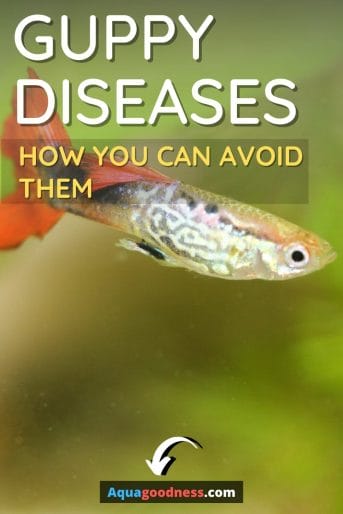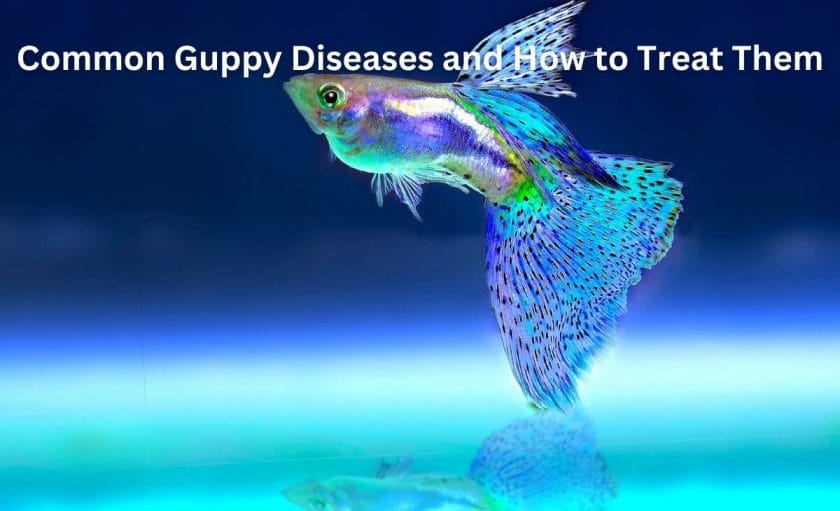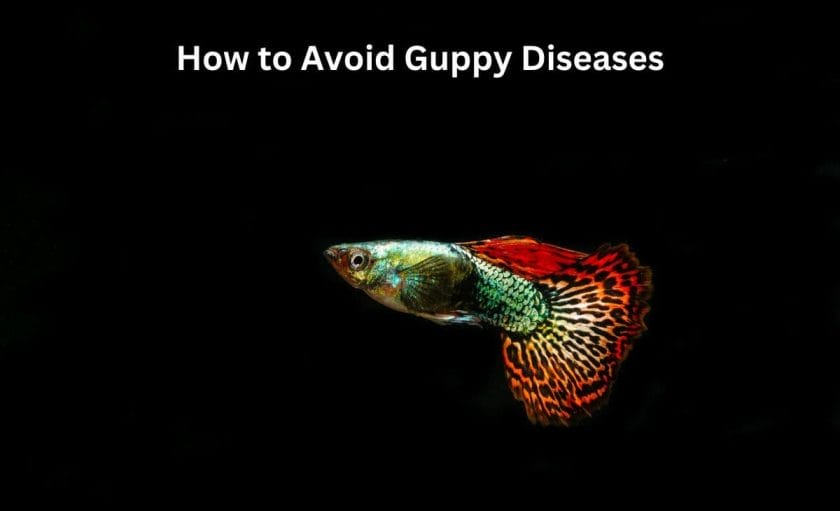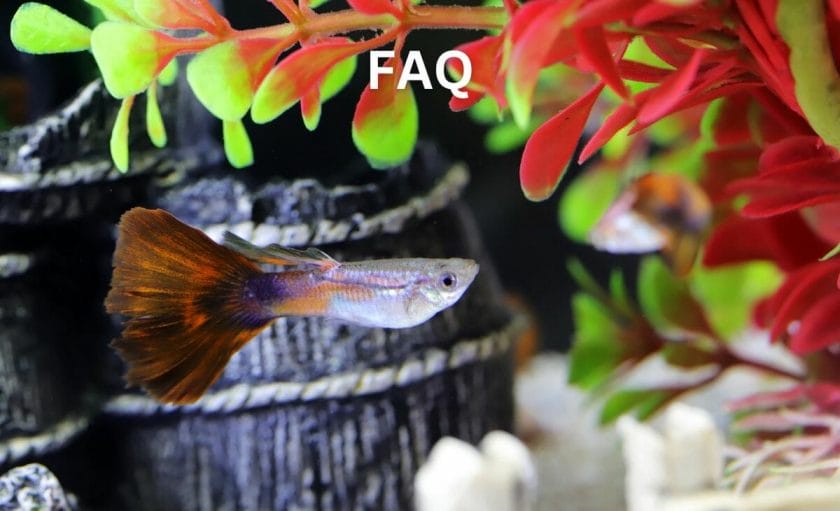Guppies are excellent to put in your tank, but they can be susceptible to diseases that can shorten their lifespan.
Here are some common diseases to be on the lookout for.
Guppies can be prone to white spot, fin rot, flukes, dropsy, and popeye. Maintaining water parameters and treating potential problems early is the best way to keep your fish happy and healthy.
Guppies are great for beginners, but diseases can wipe out a whole tank in a matter of days, which is why constant monitoring is important.
Read on, because I’m going to share important information about how to detect and prevent common guppy diseases.

Table of Contents
What Types of Diseases Can Guppies Get?

Guppies are prone to a range of diseases that can affect their lilfespan. Many common diseases are bacterial or parasitic, but some can be harder to detect unless observed by a veterinarian.
Bacterial Diseases
Some diseases or disorders can be caused or exacerbated by poor water quality or unideal tank conditions. For example, Aeromonas is the most common bacterial infection in freshwater fish and is the common cause of dropsy or pinecone diseases, evidenced by ragged fins and enlarged eyes.
Some fish are more susceptible to bacterial diseases, and fish may be predisposed toward infection by poor water conditions or poor sanitation. Mycobacterium for example, can spread to other fish through infection.
Skin Diseases
Fish rely on their skin to maintain the fluid balance in their body, and the mucous coating on their skin is especially important, allowing fish to glide through the water more easily. Protective compounds also protect fish from certain infections and parasites.
As such, diseases that target the skin are dangerous and common. Many protozoal infections, like ich or velvet, afflict home aquariums. These can cause death and will spread quickly.
Some larger parasites may not target the skin directly but will puncture it when they feed, causing a higher susceptibility to infection.
Parasitic Diseases
Often caused by introducing infected fish, parasitic diseases may require extensive treatment. While some parasites can coexist with fish, others can cause problems. Usually, the more parasites present in a tank, the greater the risk they pose to your guppies.
As such, it’s paramount to avoid introducing infected fish by quarantining new fish and plants for several weeks. In addition, you should thoroughly clean any hardscaping elements before switching them between tanks–or avoid swapping decorations altogether.
Some parasitic diseases have no cure or may be more prone to target certain fish.
Cancerous Diseases
Fish can develop tumors and cancerous growths just like other animals. Certain viruses can predispose fish to cancer. Fish may also be genetically predisposed to cancer, and cannot easily be diagnosed until the disease is more advanced.
Bone Diseases
Genetic disorders and vitamin deficiencies (such as a lack of vitamin C) can cause deformation of the spine, such as broken-back disease. Fish may be permanently affected by nutritional deficiencies or deformities, but in the right tank environment, it has a reduced impact on their quality of life.
Gill Diseases
Temperature shock can cause fish to develop a gill disease called gas bubble disease, as can high levels of carbon dioxide. Some parasites specifically target the gills of fish, like Dactylogyrus. Fish may ‘flash,’ brushing themselves against objects to attempt to remove the parasites.
Neurological Diseases
Rare infections like Streptococcus can affect the brain of a fish, and all fish are susceptible. Caused by nutritional imbalances in thiamine, niacin, and pyridoxine, some neurological disorders can be caused by infected spores in the tank.
Another potential cause is ammonia buildup, which is common in new tanks.
Eye Diseases
A fish’s eye is susceptible to becoming ulcerous, swollen, or infected by various diseases. For example, cataracts, a clouding of the lens, is common. Parasites like eye flukes can also cause problems for infected fish, compromising their vision.
Common Guppy Diseases and How to Treat Them

There are many diseases to be mindful of to keep your aquarium healthy, but some are more common than others. Always keep a close eye on your tank and watch for signs of abnormality. With disease, early detection is key to recovery and future prevention.
Flukes
Flukes are microscopic parasites that target the skin and gills of fish. Generally, fish who are infected with flukes have difficulty breathing, produce excess mucous, and exhibit red spots on their body.
Signs/Symptoms of Flukes
Fish may also scratch themselves on objects in the tank, harming their scales. Because flukes feed on the blood in the gills, latching on to feed, fish may appear lethargic, as swimming is more strenuous.
Higher levels of stress or improper quarantine protocols can allow flukes to take root in a tank, at which point it can reproduce and spread to other fish. Flukes is a general term for two different flatworm parasites: Dactylogyrus, which targets the gills, and Gyrodactylus, which targets the skin.
Flukes are especially dangerous for guppies because they thrive in crowded environments. Without external safeguards, you might quickly find your tank overrun with guppy fry, allowing the flukes to take root and accelerate their lifecycle.
How to Cure Flukes
Curing flukes is difficult and may require a medical diagnosis. Certain oral or injected medications can treat fish, although some medications may have additional side effects on the biological filtration of the tank.
Often, the tank or individual fish may be treated with potassium permanganate, hyposalinity solutions, or medications like Praziquantel or Prazipro. These medications disrupt the muscles of the flatworms, causing severe spasms and paralysis, effectively killing them so that they can be passed in the stool.
Ich
Ich is the scourge of many aquariums, but, as a silver lining, it’s fairly easy to spot and can be treated with at-home remedies if caught early enough. It’s caused by a parasite known as Ichthyophthirius multifilis, which attaches itself to the fish.
Signs/Symptoms of Ich
You can see ich as a tiny white spot on your fish’s skin. A highly optimistic parasite, many fishkeepers argue that ich is always present in a tank and that minimizing stress, reducing cross contamination, and keeping tank parameters in check is the only way to truly prevent it.
How to Cure Ich
Whatever the case may be, early detection is key to recovery. The ich latches onto the host, and after growing to maturity, the ich capsule falls off and begins replicating itself. Once done, the cyst bursts and new protozoa are released into the water, where they can survive for 2-3 days until they find a host.
Treating ich is challenging; the earlier you catch it, the more likely your fish will be to recover. Ich cannot affect humans, but always wash your hands thoroughly after interacting with an ich-infected tank to avoid spreading it to other aquariums. To treat ich, follow these steps:
- Confirm the diagnosis – Ich and velvet appear similar, so it’s important to identify ich by referencing images and familiarizing yourself with its appearance.
- Apply Ich-X – Formulated by Aquarium Co-op, Ich X can be dosed at 5 ml of medicine per 10 gallons of aquarium water.
- Wait 24 hours, do a 30% water change, and dose again at the same concentration
- Repeat until the ich is gone.
Ich-X and other antiparasitics can only kill ich when it is free-floating, not protected in the cyst during reproduction.
That’s why you’ll want to treat an extra day, even if you see no ich on your fish. You can remove the medication gradually through water changes, and you may want to consider additional medication, as your fish’s skin and tissue will be susceptible to bacterial and fungal diseases.
Aquarium salt is great to this effect, as it improves gill function and adds electrolytes to the tank.
Dropsy
Dropsy is a condition of fluid accumulation caused by poor tank sanitation and can take root if your fish are stressed or recovering from another illness. Often, dropsy is indicative of kidney or gill malfunction.
Signs/Symptoms of Dropsy
The first indication of dropsy is bloating caused by excess fluid retention in the body–not to be confused with pregnancy in female guppies!
Sometimes, the fish’s scales will ‘pinecone,’ swelling unnaturally.
Some other symptoms include:
- Bulging eyes
- Pale gills
- Curved spine
- Swelling near the anus
- Heavy breathing
- Redness
If not caught early, dropsy will be fatal. The mortality rate for guppies afflicted with dropsy is extraordinarily high, so in some cases, the endgame is to reduce the risk of the infection spreading and minimize the damage to your tank.
Dropsy can be caused by Aeromonas, a bacteria that is ever-present in tank environments, although it can also be indicative of parasites or another underlying health issue.
How to Cure Dropsy
The first step when you notice any of these symptoms is to quarantine any affected fish to prevent potential underlying infections from spreading. A medical diagnosis from a veterinarian can help cater your treatment plan, but you can also take some steps at home to help with treatment.
Adding salt proportional to your tank size can help improve the osmotic balance in the water, allowing your fish to expel water more effectively, reducing the swelling associated with dropsy.
Doing small water changes–not too big to avoid temperature shock–can help balance your tank’s parameters to ensure proper fish health.
Lastly, certain antibiotics can help treat dropsy, depending on the underlying condition. Because dropsy is a symptom, not an illness, it’s best to consult your veterinarian on the right course of action.
Fin Rot
Fin rot is a very common disease in aquarium fish that affects all fish. As the name suggests, the disease targets the fins of fish, causing discoloration and deterioration, which can affect the quality of life of your fish, even proving to be life-threatening in some circumstances. Affected fins may be discolored to an off-white and will shorten in length, appearing red and inflamed as the tissue decays.
Signs/ Symptoms of Fin Rot
Fin rot is caused by a myriad of bacteria, but the top three culprits are Aeromonas, Pseudomonas, and Vibrio, three bacteria that are present in the tank environment.
While bacteria are important in a tank, stress can weaken the immune system of fish so that they are susceptible to environmental factors; in fact, stress is the primary cause of fin rot, although not directly. As such, fin rot is very presentable and can be treated effectively.
Fish that have long, flowy fins like bettas or goldfish may be more predisposed to fin rot, but it can affect any fish that is stressed.
Stress can be caused by any one of, or a combination of the following factors:
- Poor water sanitation – Poor water quality is the primary cause of stress and disease. Maintaining your tank by distilling water is essential to fish health.
- Overcrowding – Too many fish can overstress the bacteria in the filter maintaining the nitrogen cycle, leading to stress as a result of poor water quality.
- Aggression – Aggressive fish can target peaceful ones, causing them stress.
- Poor diet – Nutritional deficiencies can cause fish to be more susceptible to disease.
How to Cure Fin Rot
Curing fin rot involves addressing sources of stress in your tank. Make sure your fish are fed the appropriate amount, are not overcrowded, have plenty of hiding places, and are kept with other docile fish. Monitor your tank conditions carefully using a testing kit.
If this article teaches you anything, it should be that a proactive approach to fishkeeping will always be better than a passive one.
Once your tank conditions are more stable, antibiotics can help fish recover and fight off bacterial infections.
Any of the following are used in the treatment of fin rot:
- Tetracycline
- Oxytetracycline
- Malachite green methylene blue
- Chloramphenicol
- Erythromycin
- Sulfadimidine
- Trimethoprim
- Minocycline
Velvet
Often confused with ich, velvet is a dinoflagellate parasite, not a protozoa. To make things more confusing, velvet can be caused by two different parasites. Piscinoodinium pillulare is the dinoflagellate responsible for velvet in freshwater fish, while Amyloodinium ocellatum is responsible for saltwater infections.
Both present with the same symptoms, but each requires its own treatment plan. Of course, since we’re talking about guppies, a freshwater fish, we’ll focus on the former of the two dinoflagellates.
Signs/Symptoms of Velvet
Velvet manifests as a fine yellow or white powder, and fish may experience respiratory distress or lethargy. This disease can be fatal, especially if not diagnosed quickly or correctly.
Commonly, velvet is introduced by poor quarantine protocols, allowing new fish to introduce infections, viruses, and parasites. Vendors buy and sell fish quickly, which is why disease may not be evident when you buy; of course, some vendors may be cognizant of potential issues with their fish and sell them anyway.
How to Cure Velvet
Velvet, has a life cycle similar to ich and is highly resistant to all types of treatments, except when it’s in the free-floating phase. Ideally, a veterinarian should diagnose velvet to ensure you are not confusing the disease for something else like white spot. The wrong treatment plan can waste time for your fish–or worse, be deadly.
Copper and commercial medications containing formalin or hydrogen peroxide can kill free-floating dinospores. Treat as suggested by your veterinarian; copper and other medications can affect tank parameters, so it’s important to monitor your tank conditions, particularly alkalinity and pH while you treat.
How to Avoid Guppy Diseases

There are many proactive measures you can take to reduce the likelihood of your guppies developing diseases. As you may start to realize, many guppy diseases are preventable and can be more readily treated when detected early.
The more knowledgeable you are, the better equipped you will be to handle a threat when it emerges. Preventing all potential diseases isn’t necessarily realistic, but you can give your fish a better chance of survival by implementing good fishkeeping practices.
Quarantine Your Fish
Many major retailers fish through their tanks very quickly as they buy and sell. That should ring alarm bells in your head, as the fish don’t go through quarantine processes before they are sold. As such, the onus is on you to carefully quarantine your fish in a separate tank for 4-6 weeks before introducing them to your community tank.
Some fishkeepers apply catchall medications like aquarium salt to boost immune system function. At any rate, you should be carefully monitoring your new fish for signs of disease during those 4-6 weeks.
You may also consider where you buy your fish. Sourcing your fish from ethical and reputable breeders can be more expensive, but it’s worth it for the peace of mind that the fish have been kept in optimal conditions and may be less likely to carry disease. You should quarantine breeder-bought fish all the same!
Clean Your Tank
Poor water quality can cause or exacerbate illness. Not only does poor sanitation encourage the growth of harmful bacteria, but it can also weaken the immune system of your fish by causing stress.
Distilling your water is essential to thwart illness and supplement treatment, but there’s no one-size-fits-all approach. Some aquarists recommend biweekly water changes of 25%, while others recommend up to 50% weekly.
There are convincing arguments for both, but your process for your tank should be informed by your test strip. I recommend using API’s Master Test Kit. If nitrates are above 40 ppm, it’s time for a water change.
A dechlorinator like Seachem Prime can help detoxify water and temporarily bind ammonia to allow the filter bacteria time to catch up.
You should also siphon the substrate in your tank to remove trapped pockets of gas, leftover food, and detritus left behind by your fish and plants. Doing so helps detoxify the water, removing potential sources of ammonia.
Reduce Stress
Stress is the primary cause of fish disease, and it’s vital to provide your fish a safe, natural, and clean environment to live in. First, make sure your tank is suitably sized. Guppies need a minimum of 10 gallons–more if you’re planning on letting them breed (and they will breed, believe me).
You’ll additionally want to consider increasing your tank size if you have other community fish besides guppies. Avoid tankmates that will harass your guppies and stick to a 1:3 male-to-female ratio to spread out aggression and reduce the stress any one female experiences.
Plants are a boon to any tank and serve multiple benefits. Not only do they compete with algae for resources, but they also help oxygenate the tank. Moreover, they provide hiding places for fish, even if they don’t need them, helping the environment reflect its wild counterpart.
Is It Ok to Have All Male Guppies? (Answered)
Monitor Constantly
Prevention is key to guppy health, but early detection is paramount to recovery. Get a test kit and monitor weekly to ensure parameters are within ideal ranges. Doing so will significantly reduce the risk of your tank developing illness.
Of course, every aquarist will likely face disease at some point, and when you do, recognizing signs like lethargy, labored breathing, and redness is the first step to getting your fish the treatment they need to recover. Some diseases, like velvet, are swift and deadly, while others like fin rot are an indication of a low-quality tank environment.
Either way, study your fish closely for visible signs of parasites or symptoms of irritation and seek medical advice if you suspect something’s wrong.
Feed a Varied Diet
Nutritional deficits can cause or predispose guppies to illness. Guppies need a varied diet, including the following:
- Flakes
- Pellets
- Vegetables
- Plants
- Brine shrimp
- Worms
- Daphnia
- Mealworm
What Do Guppies Eat? (50 Foods You Can Feed)
How Much Food Do I Feed My Guppies? (Answered)
What Human Food Can Guppies Eat? (Answered)
FAQs

How Do I Know If My Guppy Is Sick?
Observation is key to detecting diseases before they take root in your tank. Guppies that are sick will exhibit symptoms that match their illness, but in general, be on the lookout for bloating, bulging, lethargy, excess mucus production, and disorientation.
What Disease Is the Guppy Killer?
Ich is common and deadly to guppies when it is introduced or comes out of dormancy in a tank. Ich can feed on a host and multiply rapidly. Not only is the parasitism dangerous for guppies, but when ich detaches, it can leave open sores that are prone to infection.
What Are the Signs of Ammonia Poisoning in Guppies?
High levels of ammonia in a tank are toxic to guppies and are generally an indicator that the tank isn’t being distilled often enough. Guppies with ammonia poisoning will have red fins, be lethargic, and may gasp or breathe rapidly.
Conclusion
Guppies are great beginner fish, but it’s important to take good care of them to keep them healthy and happy. With careful planning and monitoring, you can help your guppies have a long and stress-free life.
Be sure to review the helpful information above to understand the underlying causes for guppy diseases and how you can avoid them!